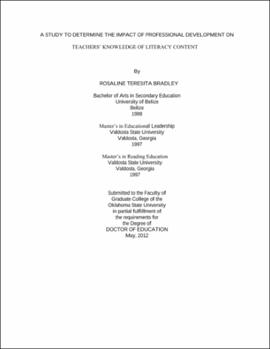| dc.contributor.advisor | Caneday, Lowell | |
| dc.contributor.author | Bradley, Michael Joshua | |
| dc.date.accessioned | 2013-11-26T08:29:47Z | |
| dc.date.available | 2013-11-26T08:29:47Z | |
| dc.date.issued | 2012-05 | |
| dc.identifier.uri | https://hdl.handle.net/11244/7098 | |
| dc.description.abstract | Scope and Method of Study: This research examines the relationship between place attachment and environmental ethics of state parks visitors and employees in Oklahoma. Furthermore, this research also examines differences that may exist among recreational users of various state parks and state park land management personnel concerning place attachment, environmental ethics, and the place attachment-environmental ethics relationship. For this study, the researcher used two instruments, each used to elicit input related to place attachment and environmental ethics respectively. The researcher included standard demographic questions to aid in analysis and understanding. | |
| dc.description.abstract | Findings and Conclusions: Via paper and pencil quantitative questionnaires, the researcher approached 711 employees and visitors in the state parks. There were 403 respondents representing users and employees from four state parks in Oklahoma, resulting in a 57% response rate. Place attachment scores for visitors and employees (3.23, 3.77) were slightly above a negligible score and significantly different from each other (F(1,401) =11.444, p=0.001). Environmental Ethics scores for visitors and employees (3.12, 3.33) were slightly above a negligible score and were not significantly different from each other (F(1,401)=1.047, p=0.307). Only three demographic factors aided in predicting place attachment, these factors were role of the respondent, time associated with the park, and level of education of the respondent. Only three demographic factors aided in predicting environmental ethics, these factors were age of the respondent, sex of the respondent, and education level of the respondent. Knowing the levels of environmental ethics aided in understanding the place attachment of a respondent, with four environmental ethics variables (2, 3, 4, & 6) being significant in place attachment prediction (F (4, 398) =8.813, p<0.001). Knowing the levels of place attachment aided in understanding the environmental ethics of a respondent, with three place attachment variables (2, 5, & 6) being significant in place attachment prediction (F (3, 399) =12.139, p<0.001). Findings indicate that state park visitors and employees are not attached to place nor have elevated levels of environmental ethics. Findings also indicate that visitors and employee demographic makeup does not reflect the demographics of the general population of Oklahoma. | |
| dc.format | application/pdf | |
| dc.language | en_US | |
| dc.rights | Copyright is held by the author who has granted the Oklahoma State University Library the non-exclusive right to share this material in its institutional repository. Contact Digital Library Services at lib-dls@okstate.edu or 405-744-9161 for the permission policy on the use, reproduction or distribution of this material. | |
| dc.title | Comparing place attachment and environmental ethics of visitors and state park employees in Oklahoma | |
| dc.contributor.committeeMember | Sheehan, Rebecca A. | |
| dc.contributor.committeeMember | Lindenmeier, Donna | |
| dc.contributor.committeeMember | Mendez, Jesse Perez | |
| osu.filename | Bradley_okstate_0664D_12008.pdf | |
| osu.accesstype | Open Access | |
| dc.type.genre | Dissertation | |
| dc.type.material | Text | |
| dc.subject.keywords | environmental ethics | |
| dc.subject.keywords | leisure | |
| dc.subject.keywords | oklahoma | |
| dc.subject.keywords | outdoor recreation | |
| dc.subject.keywords | place attachment | |
| dc.subject.keywords | state parks | |
| thesis.degree.discipline | Environmental Science | |
| thesis.degree.grantor | Oklahoma State University | |
